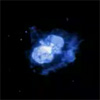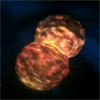CXC Home | Search | Help | Image Use Policy | Latest Images | Privacy | Accessibility | Glossary | Q&A
Images of Eta Carinae
Quicktime MPEG
The sequence begins with the Hubble's optical view of Eta Carinae, showing two lobes of gas and dust most likely ejected from the star in an eruption observed the 1840s. The view then changes to include Chandra's X-ray data in yellow. The X-ray emission shows where material previously ejected by Eta Carinae rams into nearby gas and dust, heating gas to temperatures in excess of a million degrees.
[Runtime: 0:06]
(Credit: X-ray: NASA/CXC/GSFC/M.Corcoran et al.; Optical: NASA/STScI)
Quicktime MPEG
The sequence begins with the Hubble's optical view of Eta Carinae, showing two lobes of gas and dust most likely ejected from the star in an eruption observed the 1840s. The view then changes to include Chandra's X-ray data in yellow. The X-ray emission shows where material previously ejected by Eta Carinae rams into nearby gas and dust, heating gas to temperatures in excess of a million degrees.
[Runtime: 0:06]
(Credit: X-ray: NASA/CXC/GSFC/M.Corcoran et al.; Optical: NASA/STScI)
Animation of Massive Star Explosion
Quicktime MPEG
This artist's animation depicts what astronomers think happened to Eta Carinae in the recent past, plus what it may experience in the future. Like the recently discovered supernova SN2006gy, Eta Carinae may continue to shed some of its outer layers, and then undergo a large eruption prior to a violent collapse. The explosion then would plow into the cooler expelled gas, creating a brilliant light show.
[Runtime: 0:22]
(Credit: NASA/CXC/G.Bacon)
Quicktime MPEG
This artist's animation depicts what astronomers think happened to Eta Carinae in the recent past, plus what it may experience in the future. Like the recently discovered supernova SN2006gy, Eta Carinae may continue to shed some of its outer layers, and then undergo a large eruption prior to a violent collapse. The explosion then would plow into the cooler expelled gas, creating a brilliant light show.
[Runtime: 0:22]
(Credit: NASA/CXC/G.Bacon)
Return to Eta Carinae (20 Jun 07)




